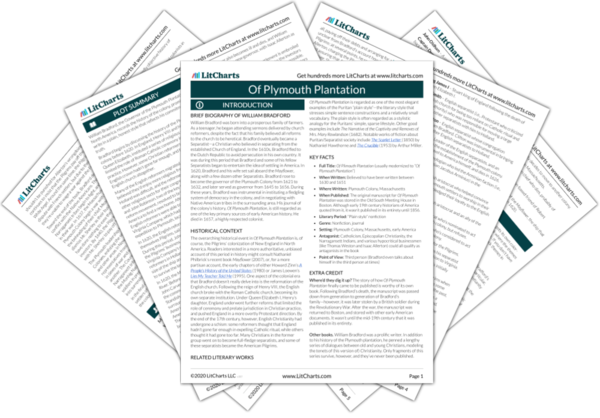Summary
Analysis
In 1634, Thomas Prince is chosen to become governor. Throughout the year, the colony receives letters from Mr. Sherley, explaining once again that the Pilgrims will have to pay Allerton’s debts.
The Pilgrims are faced with the same crisis over and over: paying off considerable debts.
Themes
Quiz
Test Yourself
Early in the year, a man named Hocking, from the nearby Piscataqua settlement, comes to Kennebec to trade. The Pilgrims in Kennebec warn Hocking not to trade on their land, since their patent gives them sole rights to trade in Kennebec. However, Hocking persists in trading. When the Pilgrims try to stop him, Hocking shoots a Pilgrim, at which point another Pilgrim shoots Hocking, killing him. Afterwards, a controversy breaks out, with the Piscataqua settlers claiming that the Pilgrims shot first. A Pilgrim is apprehended in Massachusetts and accused of having taken part in the attack in Kennebec, and the Plymouth leadership sends Captain Myles Standish to negotiate his release. Massachusetts’s leaders agree to free the unfortunate Pilgrim; however, they demand that Standish return to Massachusetts to testify regarding Hocking’s death.
The Hocking affair suggests that, as a result of stronger trading networks, English settlers are traveling more and communicating with people from other colonies, increasing the probability of conflict. But second, and more interestingly, it suggests the stratification of the colonies: Bradford arguably gives the impression that the leaders in Massachusetts are more loyal and friendly to their counterparts in Plymouth than to their own (presumably working-class) individual colonists, and would prefer to preserve trade-conducive peace than to wage war over Hocking.
Themes
Quiz
Test Yourself
Prince and Bradford try to decide how to handle the Hocking controversy. John Winthrop advises them to hold council with the Massachusetts and Piscataqua colonies. The Pilgrims do so, and send out letters asking the leaders of the surrounding colonies to meet in Boston with any relevant witnesses and evidence. However, when the Pilgrims arrive in Boston, they find that only a few Massachusetts magistrates have showed up—and nobody from Piscataqua. Nevertheless, the representatives confer, and eventually agree that Hocking was responsible for his own death.
The Hocking affair is also a milestone in the history of cooperation between New England colonies. As per Winthrop’s request, the colonies hold a trial in Boston (which, even at the time, was the central New England city). However, the trial is an embarrassing failure, since few representatives show up. In the future, however, the colonies learn how to work together more successfully.
Themes
Quiz
Test Yourself
Also in 1634, the Pilgrims send Mr. Winslow back to England to discuss Hocking’s death and to close accounts with the investors in England, since the period of their contract is expired. Winslow also brings nearly four thousand pounds of beaver, an impressive sum of money. The Pilgrims also send boats to trade with the Dutch. During one encounter, a Dutch boat raids a Pilgrim boat, partly because the commander of the Dutch boat, the Dutch Governor, is exceptionally drunk. The Pilgrims later chase after the Dutch and retrieve their goods. They try to take legal action against the Dutch, but the matter is resolved through “the mediation of friends.”
Another conflict breaks out between the Dutch and the Plymouth colonists. Bradford doesn’t go into any detail about how the conflict is resolved (does “mediation of friends” mean that the mediation is a private matter, or that there’s some kind of public hearing regarding the incident?). Once again, however, the colonies preserve peace with one another, perhaps recognizing that everybody stands to gain from free, peaceful trade.
Themes
Quiz
Test Yourself
Get the entire Of Plymouth Plantation LitChart as a printable PDF.

A tribe of Indians living in Connecticut begins to suffer from a mysterious disease that virtually wipes out their entire population. A small battalion of Dutch traders, who’d previously been living among the Indians, are able to get away from the epidemic and reach Plymouth, where the Pilgrims treat them kindly and provide them with food. The Dutch are “very grateful for this kindness.” Many more Indians die of the “pox,” including Sachem, a powerful chief. By divine providence, Bradford says, not a single Englishman dies.
Little did Bradford realize that this “mysterious disease” was, in all likelihood, spread by European settlers whose ancestors had long since developed immunities to it. Bradford attributes the English settlers’ survival to divine mercy—but modern readers know that their survival was a matter of biology, genetics, and luck.
Themes
Quiz
Test Yourself












